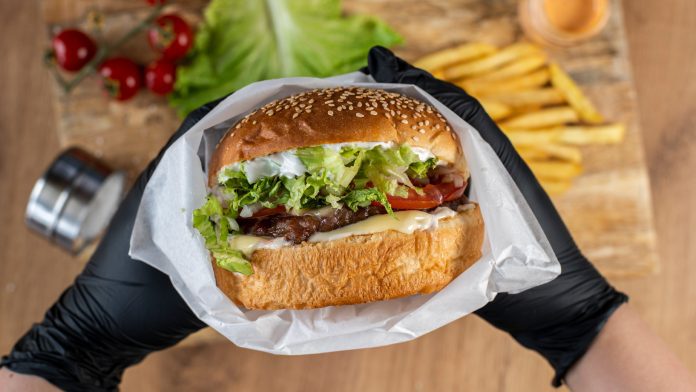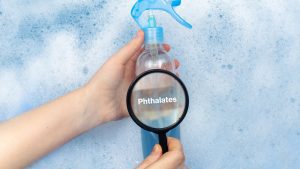
Health Europa speaks to Dr Lariah Edwards from George Washington University, lead author of a new study which investigated the presence of phthalates and other plasticisers in fast-food, many of which are problematic for human health.
In recent years, streams of research have shed light on the ways in which our exposure to certain chemicals can cause adverse health effects. One class of chemicals that has warranted widespread public health concerns is phthalates. Widely used as a binding agent in plastics to impart pliability, phthalates can be found in many consumer and household items including personal-care and cleaning products. In 2003, the US Center for Disease Control indicated that phthalates exposure was widespread in the US population with a common conduit being food and drink. It is also thought that the presence of phthalates in indoor spaces means many of us are exposed through inhalation as well absorption through the skin. Studies have indicated that exposure to phthalates is linked to a range of health implications including reproductive problems, neurodevelopmental issues, asthma, attention-deficit hyperactivity disorder and breast cancer.
While legislation has been implemented to restrict certain phthalates in children’s toys, there remains a lack of awareness for the consumer about the presence of phthalates in items they could be using, or consuming, on a daily basis. A recent study carried out by researchers at the George Washington University detected 10 of 11 potentially harmful chemicals in fast-food samples which they purchased from popular US fast food outlets. As well as identifying a phthalate called DnBP in 81% of the samples studied, 86% of the foods contained a replacement plasticiser called DEHT which is used increasingly as a replacement for phthalates, though their impact on human health is not yet fully understood. To discuss the findings of the study in more detail, Health Europa spoke to its lead author, postdoctoral scientist Dr Lariah Edwards.
What were your overall aims with this study?
My group, including Dr Ami Zota, have published and seen that there is an association between fast food consumption and concentrations of plasticisers, particularly phthalates, in people. There is a growing body of literature that has documented the association between fast food consumption and concentrations of these phthalates in people’s bodies, but there was a lack of data about what the concentrations actually were in these fast-food items. The goal of our study was therefore to analyse the level of phthalates in prepared foods available at US fast-food chains as well as to examine the presence of other novel, replacement plasticisers that are being used in place of banned or restricted phthalates.
How do these chemicals make it into foods? Did the levels of chemicals vary across different food groups?
These chemicals are not intentionally added to foods, they are added to many of the products that are used in food preparation and packaging. Phthalates and replacement plasticisers are chemicals used to make plastics more malleable and these can migrate out of the plastics and into the food. Replacement plasticisers started to emerge because years ago, people started to raise concerns about the health impacts of phthalates, however further studies are needed to understand the potential health risks of these replacement plasticisers.
These chemicals are used widely in food production such as conveyor belts and food handling gloves, but they do not stay within the products they are added to and can therefore migrate out and get into the foods that are in contact with these materials.
In all the food items that we tested, we found that ortho-phthalates and replacement plasticisers were predominantly in items that contained meat. This is consistent with what we see in literature referencing similar studies around grocery and other food items, not necessarily fast foods; they found higher concentrations of these chemicals in meat and dairy products. We believe part of the reason for this is because these chemicals are attracted to fat.
What is the regulatory situation for these chemicals? Is the amount of chemicals in the food within the EPA and/or FDA guidelines?
The concentrations that we found in the food samples were lower than the regulatory guidelines set by the US EPA. However, it is important to note that the EPA is currently reassessing those guidelines for all of the ortho-phthalates by conducting risk assessments to determine and revaluate these regulatory guidelines.
The regulatory guidelines around phthalates in the US are pretty patchwork. At present, phthalates are only regulated in children’s toys and children’s products. It is interesting that the phthalates present in a child’s fast-food toy are more heavily regulated than those present in the food they are consuming.
What types of health implications are linked to phthalates?
For ortho-phthalates, there is enough literature and scientific evidence from both human and animal studies for us to be concerned. These chemicals have been linked to reproductive issues, particularly male reproductive issues and a lot of the regulatory guidelines that were set around phthalates were because of this. There are also developmental concerns; a group of scientists here in the US flagged the link between phthalates exposure and neurodevelopmental problems in children, so issues with learning, attention, and memory. There is enough literature out there for us to be concerned about the impact phthalates exposure can have on human health.
There is, however, not a great deal known or a great deal of literature about the potential health impacts of the replacement plasticisers that we studied. This is unfortunate, because we found a high percentage of these replacement plasticisers in the fast-food samples and we do not yet know what they could be doing to us long term.
Are there particular demographics or groups who are more at risk of consuming these chemicals?
In the US, there have been studies that have shown that certain groups, typically Black Americans, eat more fast food than white Americans, and there could be a myriad of reasons of why this is, including how where you live can affect your health. There are reports that say there are more fast-food restaurants in primarily Black neighbourhoods. So, when we think about those streams of evidence it is easy to see how Black Americans may be consuming more fast food than other groups and they will therefore have a disproportionate amount of exposure to these phthalates or replacement plasticisers we are finding in these foods. This is a health equity concern and something we are all thinking about a lot right now, especially because of COVID.
What protective measures can people take to reduce their exposure to phthalates? Should we believe packaging that says BPA or phthalate free?
That is always a concern. I think it is great when companies state their product is phthalate free on the packaging, but there have been instances where products have been tested and those harmful chemicals are present, and that is unfortunate.
In terms of protective measures, we found more of these chemicals in meat products, so if you are going to consume fast food, consume lower on the food chain and eat meat-free items. Phthalates and plasticisers are found in many personal care and household products so in terms of reducing your risk at home, try to find products that are fragrance free because a lot of phthalates are used to make fragrances and that is not always indicated on labels. Similarly, try to avoid microwaving your food in plastic containers.

I recognise that it is not always feasible to reduce exposure to phthalates through what we consume. We know fast food is a cheap alternative to cooking at home and for some people, they rely on this more than others so it can be hard to avoid.
While I can give people all the advice, no amount of individual action can bring phthalate exposure down to zero. This is really why we need these regulatory actions to help protect people from being exposed to these harmful chemicals that are difficult to avoid in our daily lives.
What kind response have you had from the study? How would like to see the study inform future strategies around food regulation?
We have had a great media response so far and it is great that so many people are interested in this work. It is good to be building upon the literature already published about phthalates and seeing our work alongside other interesting pieces such as the recently released paper by Dr Leo Trasande which documented the connection between phthalates exposure and overall mortality.
Ideally, what I want with this work is that it is disseminated; it gets out to people, consumers, as well as to policymakers so they can use it. I think moving forward, we would love to expand this work to include more restaurants because there were only so many restaurants where we could collect samples in one city. Likewise, we only collected gloves from a subset of restaurants so collecting gloves from additional food outlets would really help us to characterise and better understand the contamination in fast food items.
There really is a lack of literature in the US about the concentration of these phthalates and replacement plasticisers in fast-food meals and so this is just a piece of the puzzle, and we need more data to fully understand the impact.
Dr Lariah Edwards
George Washington University
www.gwu.edu
This article is from issue 20 of Health Europa Quarterly. Click here to get your free subscription today.









